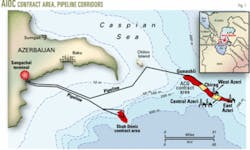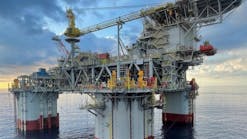BP and partners received approval for the final development phase of the Azeri-Chirag-deepwater Gunashli (ACG) project in the Azerbaijan sector of the Caspian Sea. This phase targets drilling in the deepwater Gunashli field and West Chirag field from a planned 48-slot drilling, utilities, and quarters platform that will be bridge-linked to a production, compression, water injection, and utilities platform.
The ACG contract area covers 432 sq km, east-southeast of Baku, in water 100-400 m deep (Fig. 1). Recoverable reserves are estimated to be 5.4 billion bbl.
The State Oil Co. of the Azerbaijan Republic (SOCAR) and the Azerbaijan International Operating Co. (AIOC; currently nine foreign oil companies) signed a production sharing agreement in September 1994, under which SOCAR has a 10% working interest. The PSA became effective Dec. 12, 1994, and is known as the "Contract of the Century."
Built in Finland by Rauma Repola Oy, the Dada Gorgud was the first semisubmersible drilling rig in the Caspian Sea. The rig is a Friede & Goldman L-907 enhanced design (Fig 2; photo by Steve Thorley GlobalSantaFe Corp.).
null
Approval for Phase 3, the final development phase of ACG, was announced in Baku on Sept. 20, during celebrations of the 10-year anniversary of the PSA.
BP PLC (34.1%) was appointed operator for the AIOC in 1999. Other participants are Unocal Khazar Ltd., a wholly owned subsidiary of Unocal Corp. (10.3%); Inpex Southwest Caspian Sea Ltd., a subsidiary of Japan's Inpex Corp.; Statoil ASA (8.6%); ExxonMobil Corp. (8%); TPAO (Türkiye Petrolleri Anonim Ortakligi; 6.8%); Devon Energy Ltd. (5.6%); Itochu Corp. (3.9%); Amerada Hess Corp. (1%); and Delta Oil Central Asia Ltd. (1.7%)
Development history
Work in the ACG area began in 1995 at the Chirag field. The Early Oil Project included construction of the Chirag-1 drilling and production platform, a 24-in. oil pipeline to the Sangachal terminal, and a 16-in. gas pipeline to Oil Rocks, 120 km east of Baku. Beginning construction in 1947, Oil Rocks was built on piles, 45 km offshore on the Caspian Sea. It has 200 km paved roads and a population of 5,000.
In one of many "firsts" for Caspian drilling, BP in late 2002 ran expandable sand screens in a sidetrack during extended reach drilling at Chirag-1.
First oil from EOP was delivered Nov. 7, 1997, with production reaching 136,000 bo/d in September 2002, and the field is now producing about 148,000 bo/d gross. The crude is currently being transported over a route running from Baku to Georgia's Black Sea port of Supsa ("Western Route").
Staged development of the ACG contract area is proceeding in three phases, involving 7 platforms and 448 wells. Phase 1 targets development of the central Azeri field from a central drilling and production platform with 48 slots.
Fabrication contracts worth $750 million for the Phase 1 facilities were awarded to five international companies: US-based McDermott Caspian Contractors Inc., France's Bouygues Offshore Co., Italy's Saipem SPA, France's Eiffel Construction Metallique SA, and Sweden's Pharmadule Emtunga AB International (OGJ, Dec. 10, 2001, p. 9).
McDermott built the topsides and is installing two 30-in. pipelines (drilling-production platform and compression-injection platform).
Bouygues Offshore was responsible for construction of the jackets, piles, and drilling template.
Saipem was contracted to transport and install the drilling template and jackets and float the topsides to location. The Central Azeri subsea drilling template was installed in June 2002, another first for the Caspian. One well was predrilled before template installation, and 11 others were predrilled through the template using the Dada Gorgud semisubmersible drilling rig, for a total of 10 production wells, 1 gas injection well, and 1 cuttings injection well.
The 143-m high, 12-pile Central Azeri jacket was installed in February 2004 in 120 m of water.
Topsides for the gas compression and water-injection platform (C&WP) are being built in the Amec-Tekfen-Azfen Consortium (ATA) yard at Kaspmorbourstroy, in the Bibi-Heybat oilfield area near Baku. As of early August, it was 55% complete.
The unmanned C&WP platform will contain four of the world's most powerful water pumps, designed and manufactured by Sulzer Pumps Ltd., to supply high pressure reinjection water to the East, West, and Central Azeri platforms. The 27-Mw pumps are powered by Rolls Royce RB211 gas turbines and capable of collectively injecting more than 1 million b/d at 480 bar.
The C&WP will also compress dry gas from those three Azeri platforms and the Chirag-1 platform installed during the EOP.
Production from Phase 1 has not yet started, but total reserves for the central Azeri area are projected at 1.425 billion bbl, and production is expected to peak at 375,000 bo/d.
Phase 2
Phase 2 investments will develop the eastern and western parts of the Azeri field, including construction of the West Azeri and East Azeri production, drilling, utilities, and quarters platforms (PDUQs), expansion of the Sangachal terminal and building a 30-in. oil pipeline to it, as well as expansion of the Phase 1 compression-injection platform.
The contract for engineering and procurement of the West and East Azeri drilling modules in Phase 2 went to the UK's KCA Deutag Drilling Ltd.
The PDUQ platforms will each have 48-slots arranged in a 12x4 pattern. The West Azeri PDUQ will have 34 production wells, 6 water-injection wells, and 2 cuttings disposal wells, leaving 6 unused slots. The East Azeri PDUQ will have 36 wells, 10 water injection wells, and 2 cuttings disposal wells.1
Up to 96 production, water injection, and gas injection wells will be drilled during Phase 2, and Unocal says up to 113 sidetracks may be drilled during the field's productive life.
Predrilling the Phase 2 wells from the Dada Gorgud semisubmersible is anticipated to last 576 days.1 Predrilling serves two purposes: First, to allow production as soon as possible after the platform installation, and second, to provide advance geologic and engineering information before the bulk of production drilling.
The West Azeri predrill program included nine production wells and one cuttings-disposal well and was planned for 20 months. The 150-tonne subsea drilling template was installed in mid-May 2003 with three foundation piles and two docking piles.
The East Azeri predrill program includes five production wells and one cuttings-disposal well. The East Azeri subsea drilling template was installed Dec. 15, 2003. AIOC finished drilling the first of the six wells in March 2004 and the predrilling program will take about 11 months.
The Dada Gorgud is one of two semisubmersibles operated by Caspian Drilling Co. Ltd. available for drilling off Azerbaijan (Fig. 2). CDC was formed in October 1996 through a joint venture of SOCAR (55%)and GlobalSantaFe (Formerly Santa Fe International Corp.) (45%). The Dada Gorgud is owned by SOCAR.
Dada Gorgud, originally named Kaspmorneft, was built by Rauma Repola in Poti Finland. The keel was laid in 1979, it was transported by barge in sections to the Caspian via the Volga- Balt River system and reconstructed in Astrakhan. In 1982, it became the first semisubmersible drilling rig to operate in the Caspian.
Rig manager Steve Thorley told OGJ that Dada Gorgud has had four upgrades totaling $85 million. The first upgrade, commencing in October 1995, lasted 11 months and included a complete recertification, overhaul of all equipment, increasing the accommodation to 100 capacity, replacing the cement unit, upgrading all solids control equipment, and installaing a new BOP and associated systems.
The second upgrade, commencing in February 1998, for 8 weeks, consisted of port and starboard main deck extensions, partial aft deck extension, relocation of ROV, and installation of a Maritime Hydraulics AS top drive.
The third upgrade, commencing August 1999 and lasting 14 weeks, carried out additional accommodation modifications, additional deck extensions and stiffening to install the SWACO vacuum cuttings recovery system. Deck stiffening was also carried out for cuttings injection but was later shelved.
The fourth upgrade commenced in December 2001, and lasted 13 weeks, in order to add office space and upgrade the accommodation to 120 personnel. A third mud pump was added and new Thule shakers were installed. SWACO's vacuum system was replaced by their clean-cut system.
After the two PDUQs are on location, the wells will be directionally drilled up to 4-5 km from each drilling center. The large diameter (36-16 in.) well sections in the upper 500 m of each well will be close to vertical. Smaller diameter (121/4-in., 81/2-in.) will be steered.
The first of six development wells at West Azeri was spudded in July 2004.
The total costs of Phase 2 are projected to be $5.2 billion, of which $3.8 billion will be spent on facility construction and predrilling. The remainder is designated for development drilling. First oil from West Azeri is expected second-quarter 2006 and from East Azeri in first-quarter 2007. Phase 2 facilities should yield 1.6 billion bbl oil, reaching production of 420,000 bo/d.
Phase 3
In June 2004, BP-Azerbaijan signed contracts with four companies to provide drilling services: Baker Atlas for logging; BJ Services for cementing; Halliburton Energy Services for directional drilling and logging; and Schlumberger Oilfield Services for directional drilling, logging, and cementing.
Maritime Hydraulics, a subsidiary of Aker Kvaerner, signed a memorandum of understanding with the AIOC in late June to deliver a complete drilling equipment package for a Phase 3 offshore platform in third-quarter 2005. The package is to include fully automated pipe handling equipment and advanced control systems. Project engineering will start in October 2004, in Kristiansand, Norway.
BP submitted the Environmental and Social Impact Assessment (ESIA) draft for Phase 3 to the Azerbaijan Ministry of Ecology and Natural Resources (MENR) on July 19, 2004. The 60-day public review ended Sept. 19, allowing the MENR to approve plans on Sept. 20.
First oil from Phase 3 is expected in early 2008, and overall ACG production is expected to plateau at about 1 million bo/d by 2009. Oil will be delivered to the Sangachal terminal in the Garadagh District via 30-in. subsea pipeline.
Sangachal also processes oil piped in from Shah Deniz field, southwest of the ACG contract area. Some gas is currently flared, although AIOC says that flaring will probably no longer be necessary by third-quarter 2005, except in emergencies.2 All associated gas from Phase 3 will be delivered to SOCAR.
After completion of the $12.5 million Baku-Tbilisi-Ceyhan pipeline in early 2005, oil will be transported 1,760 km via the BTC from Sangachal through Tbilisi (Republic of Georgia), to Ceyhan on the Turkish Mediterranean coast. Construction of the 42-in. pipeline began in April 2003, and the BTC project will cost $2.95 billion.
In a press meeting at the Sangachal terminal in early August, Neil Shaw, BP-Azerbaijan's vice-president for the Azeri project, said that BP had spent $4 billion on the Azeri offshore oil project to date, and Phase 1 construction for the central Azeri field was 97% complete. First oil from the Azeri field should flow between the end of the December 2004 and end of January 2005.
In a late September announcement, Statoil's International E&P project manager Andrew Sanderson said, "Looking at ways of improving the recovery factor will be the main activity next year."
References
1. AIOC, "Azeri, Chirag, and Gunashli Full Field Development Phase 2, Environmental and Social Impact Assessment," p. 4.
2. Barclay, R., Sangachal Terminal Extension and Offshore Works, Social and Resettlement Action Plan, Monitoring Panel Review," Rev. 2, February 2004.


